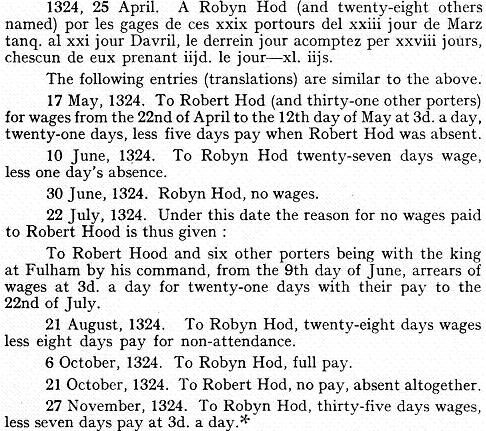The Many Robin Hoods 10
Walker mentions the records which appear in the household expenses of Edward II, (P.R.O., E 101/380/4.) that contain the accounts of payments to a number of men described as ‘grooms of the Chamber’, among them is the name of Robyn Hod. (Robin Hood Identified,YAJ vol. XXXVI.) The following entries provided by Walker are in Norman-French in the Jornal de la Chambre, and commence in April 1324, and run thus:
* Walker thought that according to the household expenses, Robyn Hod was in the King’s service from December, 1323 to November, 1324; he was obviously unaware of the earlier entry (June 1323) revealed by Holt. Walker’s list (above) still mentions Robyn Hod on 27 November, whereas Holt states that Robyn Hod was paid off on 22 November. (Robin Hood, p. 50) The reason for this is unclear.
Hunter and Walker also tried to identify some of the other characters in the ballads, such as the prioress of Kirklees and her lover Roger of Doncaster, Little John, William Scarloke, Scathelocke or Scarlett, Much the Miller’s son, Reynold Grenelef, a name used by Little John in his encounter with the sheriff, and also from the later story, Maid Marian. Hunter suggested that Matilda, wife of Robert Hode of Wakefield, was the original Maid Marian, which Walker states as fact. Walker also found a Roger of Doncaster, a chaplain, ‘But whether he was the lover of the prioress of Kirklees it is impossible to say’. The theories of Hunter and Walker, were continued by P. V. Harris (The Truth about Robin Hood, in 1951 and an article ‘Who Was Robin Hood?’ in the Folk-Lore Quarterly in 1955) and John Bellamy (Robin Hood an Historical Enquiry, in 1985). According to Harris, the Roger of Doncaster mentioned by Walker was certainly the lover of the prioress,(1) and he also found in the Wakefield Court Rolls and other sources, three men called Richard de Legh or Richard of the Lee; a surname Withondes, but no Gilbert who may have become Gilbert of the White Hand; John le Nailer for Little John; for William Scarlett or Scathelocke, the surname Shacklock, but no William; at least three Reynolds none called Grenelef, and several men surnamed Greenwood or something similar. Harris also proposed John de Segrave, keeper of Nottingham castle from 1308 to 1325 and justice of the forest beyond the Trent (1308-15) as the prototype of the sheriff in the Gest.(2) He could not find a Much the Miller’s son, the combination of a nickname with an occupational name. As Harris states, ‘the original names in ballads were often transformed out of all recognition’, which led Holt to suggests that ‘once that is allowed, identification becomes mere guesswork inspired by wishful thinking’.
1. As Holt points out, Harris’s evidence refers to at least two men called Roger of Doncaster, neither of whom was a knight, like the prioress’s lover.
2. John Bellamy has suggested that the model for the sheriff in the Gest, could have been Henry de Faucumberg, sheriff of Nottinghamshire/Derbyshire and of Yorkshire as well, in the period 1318 to 1330. (Robin Hood an Historical Inquiry, pp. 45-56)


|
